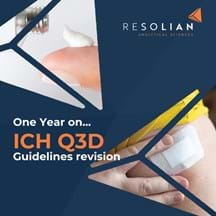Elemental Impurities Testing
Our dedicated elemental impurities team offer targeted, bespoke screening and quantitative analysis of elemental impurities in final products, excipients, APIs, Raw Materials and packaging materials.
We can perform reliable and accurate analysis in accordance with ICH Q3D and USP<232><233> guidelines by using a combination of ICP-MS and ICP-OES as appropriate. This combination enables us to measure down to ppt levels as required for impurity quantification in high dose materials, as well as up to ppm or wt% levels where an assay is required.

Applications
• ICH Q3D and USP<232><233> elemental impurity screening
• Method development and validation
• Targeted metals analysis
• Extractable and leachable testing
• Pharmacopeia testing
• Active/Drug substance testing
• Finished product testing
• Raw materials testing
• QC, stability and batch release testing
• Metal speciation
• Contamination identification
Sample preparation
• Microwave digestion or extraction
• Wet chemical digestion
• Reflux extraction
• Fusion
• Solvent extraction
Techniques
• Inductively Coupled Plasma with Mass Spectrometry (ICP-MS) - Agilent 7700x and Agilent 7900
• Inductively Coupled Plasma with Optical Emission Spectrometry (ICP-OES) - Thermo iCAP7600 Duo
Requirements for Elemental Impurities Testing
We can perform reliable and accurate analysis in accordance with ICH Q3D and USP<232><233> guidelines by using a combination of ICP-MS and ICP-OES as appropriate.
ICH Q3D elemental impurities testing
As a consequence of the new ICH/USP regulatory guidelines concerning testing of elemental impurities, the way in which pharmaceutical companies and their suppliers are required to test their Drug Product, APIs and excipients has changed dramatically. The guidelines, which aimed to set out a global policy for limiting metal impurities in Drug Products and ingredients puts these impurities in to various categories. In order to comply with the guidelines sponsors need to carry out a detailed risk assessment of their materials in terms of these different categories.
Impact of the changes
USP <231> heavy metals test was replaced with two new chapters, USP <232> elemental impurities (limits) and USP <233> elemental impurities (procedures). As a consequence the use of Inductively Coupled Plasma Optical Emission Spectroscopy (ICP-OES) and Inductively Coupled PlasmaMass Spectroscopy (ICP-MS) has become the preferred standard approach for the determination of heavy metals in Drug Products, replacing the much out dated and nonspecific/non quantitative wet chemical tests. With the added elemental specificity, accuracy and sensitivity (ppb/ppt range) afforded by ICP-OES/ICP-MS, sponsors are able to confirm that their materials meet the new compliance criteria.
Our solution
The new USP directive was implemented in January 2018 and we are already supporting a very significant industry requirement for additional ICP-OES/ICP-MS testing of Drug Products, APIs and excipients. Delivery of large volumes of ICP-OES/ICP-MS testing is not within the typical capability of pharmaceutical QC laboratories. We, however, have extensive experience in delivering high throughput routine ICP testing with short turnaround times. Our dedicated elemental impurities team is based at our state of the art cGMP facility in Cambridge (Fordham).
One Year On 

It's been over a year since the ICH Q3D guidelines were updated to include cutaneous and transcutaneous limits.
This crucial change allows the evaluation of topical products with risk-appropriate permitted daily exposures, rather than adopting more stringent parenteral limits.
